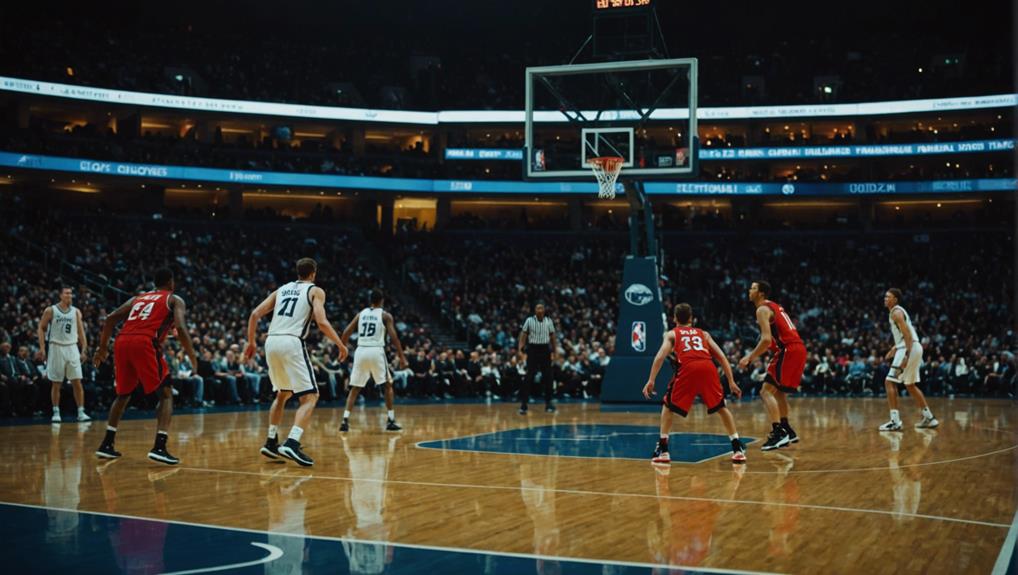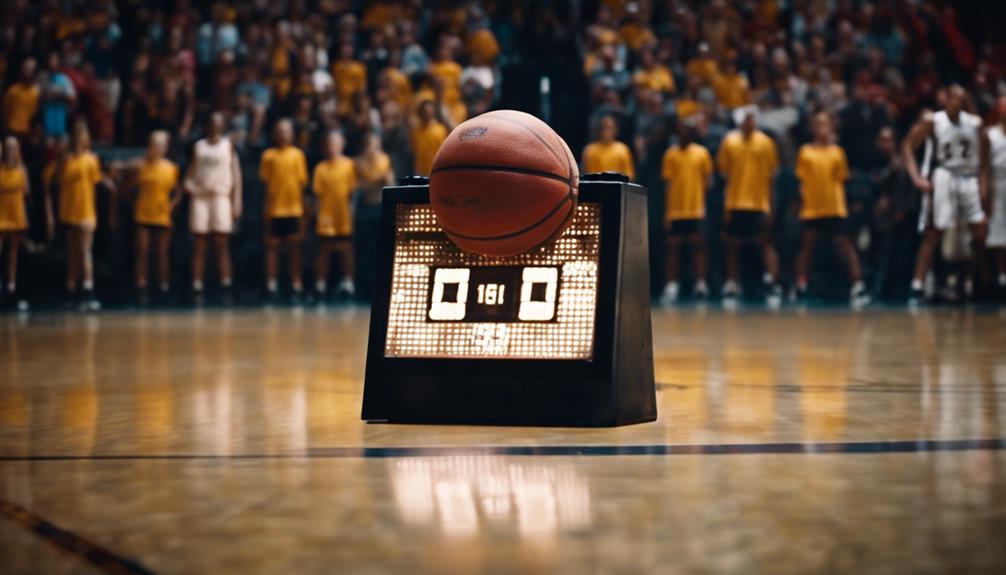
Why Does the Shot Clock Change Basketball Strategy?
May 14, 2024The shot clock changes basketball strategy by creating urgency. Players must make quick decisions and aim for high-percentage shots. Strategies revolve around time management and maximizing scoring chances. Pressure sharpens decision-making skills and forces constant offensive adjustments. Defensively, teams adapt quickly, disrupt plays, and limit scoring opportunities. The pace of gameplay accelerates, requiring efficient execution and strategic planning. Utilizing the shot clock is vital for a competitive edge and showcases high basketball IQ. Understanding its impact enhances your grasp of the game's dynamics.
Impact on Offensive Decision-Making
When facing the shot clock, teams must swiftly make critical offensive decisions to avoid penalties and capitalize on scoring opportunities. The shot clock's impact on offensive decision-making is profound in basketball. With limited time to work with, players must be strategic in their shot selection to guarantee they take high-percentage shots. Offensive strategies revolve around maximizing possession time and creating the best possible scoring chances within the shot clock window. The pressure to score within the time constraint pushes teams to enhance their decision-making skills and execute plays efficiently.
Teams need to constantly adjust their offensive strategies to adapt to the shot clock's demands. This constant need for quick thinking and precise execution hones players' abilities to make split-second decisions under pressure. The shot clock not only speeds up the pace of the game but also elevates the level of strategic thinking required on the offensive end. As a result, teams that can effectively navigate the shot clock tend to have a competitive edge in maximizing scoring opportunities.
Defensive Adjustments and Pressure
In basketball, the shot clock creates a dynamic environment that demands quick defensive adjustments and intense pressure on teams to limit scoring opportunities. With limited possession time, defenses must adapt swiftly to disrupt offensive plays and force turnovers. Teams strategize to induce rushed or contested shots as the shot clock winds down, aiming to stifle scoring opportunities.
Defensive pressure escalates as players work cohesively on defensive communication and rotations to counter offensive threats effectively within the shot clock limit. The urgency to create turnovers and defensive stops intensifies as the shot clock ticks away, requiring teams to maintain a high level of defensive intensity throughout the game.
Acceleration of Gameplay Pace

The acceleration of gameplay pace driven by the shot clock compels teams to execute offensive plays swiftly and decisively to maximize scoring opportunities. This increased pace of play demands efficiency in decision-making and execution, creating high-pressure situations where players must act quickly to avoid shot clock violations and capitalize on scoring chances.
As teams adapt to the faster tempo enforced by the shot clock, several key factors come into play:
- Essential Offensive Efficiency: Teams need to streamline their offensive plays to make the most out of limited time.
- Improved Time Management: Players develop a better understanding of managing the shot clock and making split-second decisions.
- Increased Scoring Opportunities: The quicker pace of play leads to more possessions and opportunities to score, rewarding teams that can efficiently execute their offensive strategies.
In this high-energy environment, the shot clock becomes an important component shaping teams' offensive approaches and players' decision-making skills under pressure.
Enhanced Strategic Planning Requirements
You must adapt to the accelerated pace of the game, managing time effectively and making critical decisions under pressure.
Quick thinking and strategic planning are essential in optimizing possessions and scoring opportunities within the shot clock limit.
Being aware of the shot clock time will be vital for your team's success on the court.
Time Management Impact
Strategically managing time within the shot clock limit enhances teams' ability to capitalize on scoring opportunities efficiently. Teams must employ effective time management strategies to make quick decisions and execute efficient plays under time pressure.
Effective use of possessions within the shot clock is essential for success in basketball, requiring coaches to plan and execute plays with precision. Players need to be mindful of the shot clock at all times, ensuring they maximize scoring opportunities within the allotted time frame. Time management skills play a significant role in determining a team's effectiveness in utilizing the shot clock to their advantage.
- Coaches must plan and execute plays efficiently within the shot clock limit.
- Players need to make quick decisions and execute plays effectively under time pressure.
- Strategic planning becomes important to ensure efficient use of possessions within the shot clock.
Decision-Making Under Pressure
Enhancing your strategic planning skills is imperative when faced with making quick decisions under pressure within the shot clock limit in basketball. The shot clock demands swift decision-making and execution of strategic plays to maximize scoring opportunities.
Coaches and players alike must elevate their basketball IQ to succeed in high-pressure situations and exploit the limited time effectively. Strategic adjustments in offensive plays are essential to create quality shots efficiently and manage the game clock strategically.
The shot clock not only emphasizes time pressure but also underscores the significance of time management and effective game management strategies. By honing your decision-making skills and implementing effective game management, you can navigate the challenges posed by the shot clock and optimize your team's performance on the court.
Influence on Scoring Opportunities

The shot clock in basketball intensifies the pressure on teams to swiftly create and capitalize on scoring opportunities. Teams must execute offensive plays efficiently within the limited time to score before the shot clock expires. Players need to make smart decisions and take quality shots to maximize scoring chances.
Here are key points to ponder:
- Quick Scoring: Strategies need to revolve around rapid scoring to make the most of the shot clock time frame.
- High-Paced Gameplay: The shot clock promotes a fast-paced and thrilling gameplay environment by encouraging quick scoring opportunities.
- Smart Decisions: Players must think on their feet to make sure they take quality shots and make the most of each possession within the shot clock constraints.
Adapting to the shot clock's influence on scoring opportunities requires teams to foster agility and precision in their offensive strategies to outmaneuver their opponents effectively.
Adaptation of Team Dynamics
You need to understand how the shot clock influences teamwork dynamics on the court.
Quick decision-making becomes essential in adapting to the faster pace of the game.
Adjustments are necessary to keep up with the strategic demands of efficient scoring within the time constraints.
Impact on Teamwork
Mastering the shot clock's constraints, teams must synchronize movements and decision-making to capitalize on scoring opportunities efficiently. This requires seamless teamwork, where offensive strategies are adapted to make the most of every possession.
Communication and coordination among players are crucial under the shot clock pressure, ensuring quick and effective plays. Understanding each player's role within the team framework is essential to optimize shot clock possessions and enhance scoring efficiency.
Successful teamwork in these high-pressure situations not only improves scoring efficiency but also increases overall game success. Remember, teamwork is the key to overcoming the challenges posed by the shot clock and achieving victory on the court.
- Seamless teamwork
- Communication and coordination
- Understanding player roles
Quick Decision-Making Required
Amidst the shot clock pressure, teams must swiftly adapt their dynamics to make split-second decisions that lead to scoring opportunities. The shot clock demands quick decisions and efficient execution of offensive strategies within the limited possession time.
Players need to adjust their decision-making process to guarantee timely and effective shot attempts, enhancing their ability to read and react to the fast-paced game flow. Adapting to the shot clock challenges teams to maintain a high level of alertness and strategic thinking, as every second counts towards creating scoring opportunities.
Adjustments to Pace
Teams facing the pressure of the shot clock are compelled to adjust their pace, requiring quick adaptations in their dynamics to optimize scoring opportunities within the limited possession time. The adjustments to pace involve:
- Enhancing offensive execution to make quicker decisions.
- Maximizing possessions to create quality scoring opportunities.
- Developing faster changes and strategic plays to capitalize on the shot clock.
Competitive Edge in Modern Basketball
In modern basketball, gaining a competitive edge hinges on effectively utilizing the shot clock to dictate the pace of play and outmaneuver opponents. The shot clock injects urgency into the game, challenging teams to make quick decisions on offense.
To excel, teams must strategize to maximize possessions and create quality scoring opportunities within the time limit. Players need to showcase higher basketball IQ levels to manage shot clock time efficiently.
Coaches play an important role in adapting strategies to cope with the time pressure imposed by the shot clock, enhancing their team's competitiveness. The shot clock ultimately rewards teams that can execute effectively under time constraints, emphasizing the importance of efficiency in modern basketball.
Conclusion
As you navigate the fast-paced world of basketball, the shot clock stands as a timeless adversary, pushing teams to make quick decisions and strategic plays.
Embracing this modern challenge will be crucial to accessing success on the court and gaining a competitive edge in the game.
So, grab your sneakers, channel your inner baller, and remember: in basketball, time truly is of the essence.


